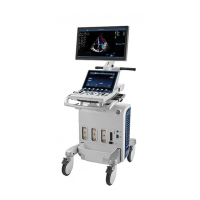Advanced cardiac measurements and analysis
Vivid S70 / S60 – User Manual 8-43
BC092760-1EN 01
Tracking correction
The following can be done if tracking needs correction:
• Press EF dual to display ES and ED frames side-by-side.
• Adjust ES frame and ED frame controls if different frames
need to be selected for ES and ED.
• Edit misaligned points on the endocardial border trace as
described on ‘Editing the endocardial border trace’ on
page 8-43.
• Create a new endocardial border trace (See ‘To create a
new ROI’ on page 8-26)
Possible causes of poor tracking
• Erroneous placement of the basal points when defining the
border. If the basal points are placed too far from the
annular region, the border segments at the annular base will
not move together with the underlying 2D image throughout
the entire heartbeat.
• Erroneous placement of the apex point when defining the
border. The point should be placed so that the resulting
border trace covers mainly the endocardium. If the apex
point is placed too high, the border trace will mainly cover
the epicardium resulting in poor tracking.
• Too much clutter. Images with too much static clutter will
result in poor tracking.
Trace adjustment of the endocardial border
If the automatic endocardial border detection is not optimal the
user can either adjust the trace or create a new trace as
described below.
Editing the endocardial border trace
• Enter the Define ROI stage.
• Adjust the trace by moving the cursor over the endocardial
border trace, select an anchor point and drag it to a new
location. The shape of the endocardial border trace is
updated accordingly.
In the upper right of the screen there is a pictogram indicating
the core features of a good APLAX AutoEF ROI.
Poor tracking quality may lead to incorrect measurement
results. The tracking must be visually controlled and validated.

